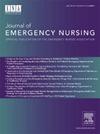Predictive Performance of the KINDER 1 Fall Risk Assessment Tool in a Regional Health System
IF 2.3
4区 医学
Q2 EMERGENCY MEDICINE
引用次数: 0
Abstract
Introduction
Patient fall risk assessment in the emergency department poses a unique challenge as fall risk is often associated with risk factors other than inpatient falls. While there are many inpatient fall risk assessment tools, few have been used or validated in the ED environment. Therefore, this study examined the predictive performance of the KINDER 1 Fall Risk Assessment Tool in 10 emergency departments.
Methods
A retrospective cohort design was used. Data were collected from November 15, 2023, to April 30, 2024, as a part of an electronic pilot of the KINDER 1 Fall Risk Assessment tool. Inclusion criteria encompassed all adult (≥18 years) ED visits during which a KINDER 1 fall risk assessment was completed. Descriptive statistics were used to describe overall sample characteristics. Predictive performance was calculated via multiple accuracy measurements.
Results
KINDER 1 assessments were completed on 64,811 patients, of which 40 patient falls met inclusion criteria for final analysis. The mean age of the patients who fell was 58.46 years (±18.38). Final sensitivity was 77.5%, and the specificity was 75.8%. Fall prevalence was 0.06%.
Discussion
KINDER 1 exhibited a sufficiently high degree of sensitivity and specificity, supporting an acceptable level of predictive performance. Additional research is recommended to compare the reliability and predictive validity of KINDER 1 to the emergency Hester Davis Scale and the Memorial Emergency Department Fall Risk Assessment Tool, as well as to compare the usability of the tools for nurses in a triage setting.
KINDER 1跌倒风险评估工具在区域卫生系统中的预测性能
简介:在急诊科的病人跌倒风险评估提出了一个独特的挑战,因为跌倒风险往往与住院病人跌倒以外的危险因素有关。虽然有许多住院患者跌倒风险评估工具,但很少在急诊科环境中使用或验证。因此,本研究在10个急诊科检测了KINDER 1跌倒风险评估工具的预测性能。方法:采用回顾性队列设计。数据收集于2023年11月15日至2024年4月30日,作为KINDER 1坠落风险评估工具电子试点的一部分。纳入标准包括所有成人(≥18岁)ED就诊,期间完成KINDER 1跌倒风险评估。描述性统计用于描述总体样本特征。通过多次精度测量计算预测性能。结果:64,811例患者完成了KINDER 1评估,其中40例患者符合最终分析的纳入标准。患者平均年龄58.46岁(±18.38岁)。最终敏感性为77.5%,特异性为75.8%。秋季患病率为0.06%。讨论:KINDER 1表现出足够高的敏感性和特异性,支持可接受的预测性能水平。建议进一步研究比较KINDER 1与急诊Hester Davis量表和纪念急诊科摔倒风险评估工具的可靠性和预测效度,以及比较这些工具在分诊设置中对护士的可用性。
本文章由计算机程序翻译,如有差异,请以英文原文为准。
求助全文
约1分钟内获得全文
求助全文
来源期刊
CiteScore
3.10
自引率
11.80%
发文量
132
审稿时长
46 days
期刊介绍:
The Journal of Emergency Nursing, the official journal of the Emergency Nurses Association (ENA), is committed to the dissemination of high quality, peer-reviewed manuscripts relevant to all areas of emergency nursing practice across the lifespan. Journal content includes clinical topics, integrative or systematic literature reviews, research, and practice improvement initiatives that provide emergency nurses globally with implications for translation of new knowledge into practice.
The Journal also includes focused sections such as case studies, pharmacology/toxicology, injury prevention, trauma, triage, quality and safety, pediatrics and geriatrics.
The Journal aims to mirror the goal of ENA to promote: community, governance and leadership, knowledge, quality and safety, and advocacy.

 求助内容:
求助内容: 应助结果提醒方式:
应助结果提醒方式:


